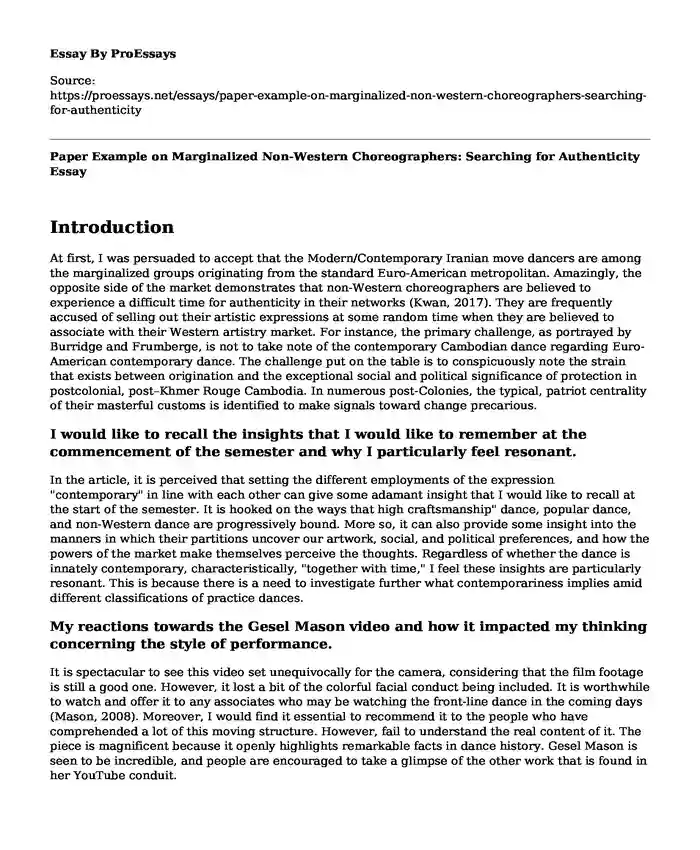Introduction
At first, I was persuaded to accept that the Modern/Contemporary Iranian move dancers are among the marginalized groups originating from the standard Euro-American metropolitan. Amazingly, the opposite side of the market demonstrates that non-Western choreographers are believed to experience a difficult time for authenticity in their networks (Kwan, 2017). They are frequently accused of selling out their artistic expressions at some random time when they are believed to associate with their Western artistry market. For instance, the primary challenge, as portrayed by Burridge and Frumberge, is not to take note of the contemporary Cambodian dance regarding Euro-American contemporary dance. The challenge put on the table is to conspicuously note the strain that exists between origination and the exceptional social and political significance of protection in postcolonial, post–Khmer Rouge Cambodia. In numerous post-Colonies, the typical, patriot centrality of their masterful customs is identified to make signals toward change precarious.
I would like to recall the insights that I would like to remember at the commencement of the semester and why I particularly feel resonant.
In the article, it is perceived that setting the different employments of the expression "contemporary" in line with each other can give some adamant insight that I would like to recall at the start of the semester. It is hooked on the ways that high craftsmanship" dance, popular dance, and non-Western dance are progressively bound. More so, it can also provide some insight into the manners in which their partitions uncover our artwork, social, and political preferences, and how the powers of the market make themselves perceive the thoughts. Regardless of whether the dance is innately contemporary, characteristically, "together with time," I feel these insights are particularly resonant. This is because there is a need to investigate further what contemporariness implies amid different classifications of practice dances.
My reactions towards the Gesel Mason video and how it impacted my thinking concerning the style of performance.
It is spectacular to see this video set unequivocally for the camera, considering that the film footage is still a good one. However, it lost a bit of the colorful facial conduct being included. It is worthwhile to watch and offer it to any associates who may be watching the front-line dance in the coming days (Mason, 2008). Moreover, I would find it essential to recommend it to the people who have comprehended a lot of this moving structure. However, fail to understand the real content of it. The piece is magnificent because it openly highlights remarkable facts in dance history. Gesel Mason is seen to be incredible, and people are encouraged to take a glimpse of the other work that is found in her YouTube conduit.
The question that remains with me.
The question that remains in me is the question of what exactly defines the black dance. However, the two pioneering African American dancers and the renowned choreographers, Hemsley Winfield and her counterpart Edna Guy had made an effort to respond to the subject of interest. They attempted to return to the impending question through the production of the first contemporary dance show. The dance was precisely devoted to the art of black dancers. Five decades later, a craftsman bearing the name Ishmael Houston created a postmodern presentation episode that was entitled "Parallels" that sort to shove the limits of what was customarily viewed as African-American move styles. However, this did not justify answering the question of what delineates the black dance.
References
Gesel Mason. (2008). How to Watch a Modern Dance Concert or What in the Hell Are They Doing Onstage? [Video]. YouTube. https://www.youtube.com/watch?time_continue=278&v=KnX76ZfN-Yw&feature=emb_logo
Kwan, S. (2017). When is contemporary dance?. Dance Research Journal, 49(3), 38-52.
Cite this page
Paper Example on Marginalized Non-Western Choreographers: Searching for Authenticity. (2023, Nov 19). Retrieved from https://proessays.net/essays/paper-example-on-marginalized-non-western-choreographers-searching-for-authenticity
If you are the original author of this essay and no longer wish to have it published on the ProEssays website, please click below to request its removal:
- My Experience With Social Media Addition - Essay Sample
- Accrington Stanley and Social Media Marketing Essay
- Essay on Ancient Luxor Temple: An Architectural Marvel Since 14th BC
- Essay Sample on The Carringtons & Colbys: A Netflix Dynasty
- Harnessing the Power of Social Media for Business Growth - Essay Sample
- Movie Analysis Essay on Alex Gerald's Ex Machina
- Essay Sample on Traditional News vs. New Media: Biasness and Accuracy







